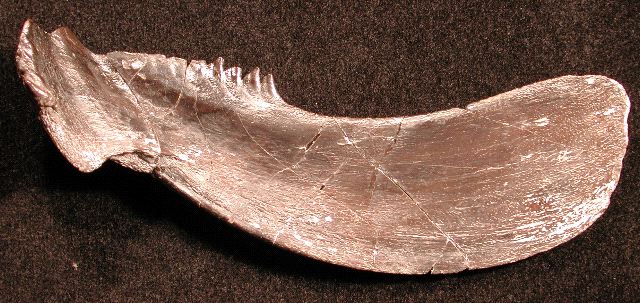Fossil quality

 (80 kb) Beautifully preserved fossils. Many examples of high-quality preservation, due to rapid burial and low oxygen levels in the sediments surrounding the remains, were discovered in the past and continue to be on a regular basis, have yielded many fantastic discoveries that continue to this day.
(80 kb) Beautifully preserved fossils. Many examples of high-quality preservation, due to rapid burial and low oxygen levels in the sediments surrounding the remains, were discovered in the past and continue to be on a regular basis, have yielded many fantastic discoveries that continue to this day. Three-dimensional fossil specimens, just as wide now as they were when alive, provide a very accurate idea of what many of the fishes looked like. The insides of intact Eusthenopteron skulls were studied by X-rays, for example, and specimens of the placoderm genus Bothriolepis were used to correct earlier scientific and artistic reconstructions, adding height to the overly flattened representations. Other excellent examples include specimens of Scaumenacia in which the delicate fins appear “suspended” in sediment, providing valuable information about their flexibility.

 (68 kb)Fish made of hundreds of small pieces were fossilized without falling apart, a very rare phenomenon indeed. The osteostracan Escuminaspis, for example, had a body covered in a mosaic of thousands of small bony plates, all of which remain in their original positions on in a 40-cm long fossilized specimen. In general, specimens of most fish species at Miguasha, even those that tend to quickly break apart, are found complete.
(68 kb)Fish made of hundreds of small pieces were fossilized without falling apart, a very rare phenomenon indeed. The osteostracan Escuminaspis, for example, had a body covered in a mosaic of thousands of small bony plates, all of which remain in their original positions on in a 40-cm long fossilized specimen. In general, specimens of most fish species at Miguasha, even those that tend to quickly break apart, are found complete.
Fossils of juvenile fish allow the skeletal growth and ossification of many species to be established.
Preserved traces of soft tissue are numerous. For example, there are many Bothriolepis specimens with their non-bony portions clearly etched into the rock, as if still in motion. Other samples reveal display of blood vessels and aspects features of their internal anatomy. Specimens of boneless fish, such Euphanerops and Endeiolepis, show traces of the gill system, blood vessels, the digestive track, fins, etc.
The contents of fossilized excrement, known as coprolites, fossilized excrement, can also be analyzed in detail.
Plant leaves are still slightly curved and allow us to observe their fine nervures. Fertile parts are even preserved with clusters of sporangium intact.
Site map | Feedback | Links | Sources | Credits
Fossil quality
<< Representativity | Specimens by the thousands >>

Title: Blood vessels
Author: Parc national de Miguasha
Sources: Parc national de Miguasha
Year: 2003
Description:
These blood vessels left their mark on the ventral internal surface of the thorax in a specimen of Bothriolepis canadensis, a placoderm fish. The blood vessels converge toward a dark central zone that represents the heart region.



